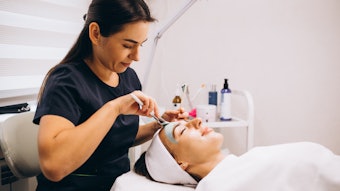
The desire to remove excess hair has been part of the human condition as far back as 30,000 B.C. First, sharpened flints and clamshells were used to scrape off unwanted body hair then the Ancient Egyptians discovered sugaring, which gave way to waxing. Today, laser hair removal is the No. 1 laser treatment offered in the United States, and it consistently ranks in the top three most-requested nonsurgical cosmetic procedures.
As technologies have improved, treatment times have shortened and the list of potential candidates for laser hair removal has increased. Here are expert strategies for obtaining the best outcomes for patients who want to permanently banish their unwanted body hair.
Selecting a Device
Intense pulsed light (IPL), and alexandrite, diode and Nd:YAG lasers are all effective in removing unwanted hair—particularly for patients with fair skin and dark hair. With so many devices on the market, Michael Gold, MD, FAAD, founder of the Gold Skin Care Center in Nashville, encourages providers to look for reputable companies and then choose the device that feels most comfortable in their hands.
“Today’s laser machines are much better than they were in the past,” he says. “Pick a machine that you’re comfortable with from a manufacturer that has been around for several years—such as Aerolase, Alma Lasers, Cynosure, InMode, Lumenis or Sciton. Then take some time to train and research so you can select the right settings for each patient.”
Some practices have one go-to device; others rely on several devices enabling them to treat a range of skin and hair types or combine treatment modalities for better results.
The Syneron-Candela GentleMax Pro and the Cynosure Elite+ are favorites of E. Victor Ross, MD, a dermatologist and laser specialist with Scripps Clinic Carmel Valley in San Diego, California, who cites their efficacy, ease of use and fast treatment times. Both are dual wavelength lasers—755nm alexandrite and 1,064nm Nd:YAG —and both offer spot sizes from 3mm up to 24mm.
Jeremy Fenton, MD, a dermatologist with the Schweiger Dermatology Group in New York City prefers the Cynosure Vectus, an 810nm diode laser that offers small and large handpiece options. “Its biggest advantage is the speed with which you can do a treatment,” he says. “With the large handpiece and a rapid-firing rate, I can treat an entire back in less than 10 minutes.” The device also includes the Skintel Melanin Reader, a skin type/pigment measuring system that helps guide new users in choosing their settings. “More advanced users will likely choose settings based on their experience,” says Dr. Fenton.
Mitchel Goldman, MD, a volunteer clinical professor of dermatology at the University of California, San Diego, and medical director of West Dermatology in San Diego, uses a combination of diode and alexandrite laser treatments to achieve the most thorough hair removal. “We use the LightSheer Duet on first-time patients to treat large areas like the back or the legs because of the speed and lessened pain,” he says. “After two treatments, we switch to the alexandrite laser to increase efficacy on small diameter and lighter hairs. We only use the 1,064nm Nd:YAG for dark-skinned patients.”
Cooling Options
In addition to offering larger spot sizes for shorter treatment times, improvements in cooling technologies have made laser hair removal much more tolerable for patients. Options include cryogen spray cooling, cold-air cooling or contact cooling through a chilled sapphire tip.
“When using contact cooling devices, always physically check the device yourself before firing to make sure it feels cool to the touch,” says Dr. Fenton. “Then pause for a moment before the laser fires when moving the contact cooling along the skin, to give the cooling a moment to work.”
In lieu of contact cooling, “both cryogen spray and cold-air cooling methods are good—the cold air provides better analgesia, but the spray provides better skin protection,” says Dr. Ross.
Dr. Goldman finds that patients experience a little more pain with the cryogen spray so he prefers cold-air cooling.
Dr. Fenton notes that proper skin cooling becomes even more important when working with darker-skinned patients due to the increased risk of burning and hyperpigmentation.Skin Types IV-VI
For patients with skin types IV and higher, the safest option is a 1,064nm Nd:YAG laser. “With other wavelengths, you can easily damage the epidermis,” says Dr. Ross.
The darker the skin, the longer the pulse should be. “With a constant amount of energy, extending the duration over which that energy is delivered is going to be safer,” Dr. Fenton says. “When in doubt, always keep fluence low and pulse duration long.”
He recommends starting with a low fluence and spot testing prior to treatment to monitor for post-inflammatory hyperpigmentation. Before increasing the energy at subsequent treatments, Dr. Fenton recommends a second spot test. “Do a few pulses in a less discrete area with the increased settings,” he says. “That will help you feel more comfortable with the boosted power.”
In addition to increased risk of burning and hyperpigmentation, some dark-skinned patients are at increased risk of another complication, Paradoxical Laser Induced Growth Stimulation (PLIGS). This is when thin dark hairs on the necks and cheeks of men and women grow back thicker after laser exposure, says Dr. Ross. It most commonly affects patients from Pakistan, Iran, Saudi Arabia, Spain, Italy and other countries in these regions. “Two or three months after laser treatments, thicker hair than what was there before appears in the treated area,” says Dr. Ross. “There’s a 50 percent chance of this happening with people from these countries, so it’s unwise to do the laser procedure on them.”
Another group at increased risk for PLIGS is people taking testosterone supplements for muscle building. “Make sure your candidates for hair removal aren’t taking hormonal supplementation,” Dr. Goldman warns.
Light Hair, Fair Skin
Despite technological advances, “no laser works well for light or blonde hair,” says Dr. Gold.
Dr. Fenton has had some good results using the Syneron-Candela GentleMax Pro 755nm laser with aggressive settings, “as long as the hair has some pigment,” he says. “Lighter-skinned patients can generally tolerate much higher energy. But so far nothing has worked on nonpigmented hairs. In some cases, the patient opts for electrolysis.”
Treatments on the horizon may offer better outcomes for those with light or nonpigmented hair. “For the past five years I’ve been working with Sienna Biopharmaceuticals on ultra-efficient, near-infrared light-absorbing silver particles or photoparticle therapy,” says Dr. Goldman. “These particles are silica-coated, nanoscale plates tuned to wavelengths of common dermatologic lasers (i.e., 755nm, 810nm and 1,064nm). I predict we will have a device to treat light skin and vellus white hair (like the hair that develops after menopause) in the near future.”
Clinical Endpoints
One the greatest challenges of laser hair removal is achieving efficacy without burns or injuries. To ensure you are reaching the correct energy levels, keep an eye on the skin during treatment. Dr. Goldman looks for follicular erythema or perifollicular erythema as his endpoints. “When you see the redness around the hair follicle, it means that the device has been heated enough to cause destruction,” he says.
In addition to follicular erythema, Dr. Ross watches for edema around the hair follicle—similar to goose bumps—which can take several minutes to appear. If you see skin redness or graying of the skin, your energy levels are too high.
Dr. Fenton agrees that perifollicular edema and erythema are signs of correct treatment settings. “Any hair present in the hair follicle should also be singed and many will come out of the follicle during the process or with gentle scraping afterwards,” he says.
Prior to initiating treatment, it is important to set realistic expectations. “The term ‘laser hair removal’ is somewhat misleading,” says Dr. Fenton. “A more accurate term is ‘permanent laser hair reduction.’ Patients should know that many people need some touch-ups down the road, and not all hair can be completely removed.”
Heather Larson is a freelance writer based in Washington State.
Image copyright Getty Images











